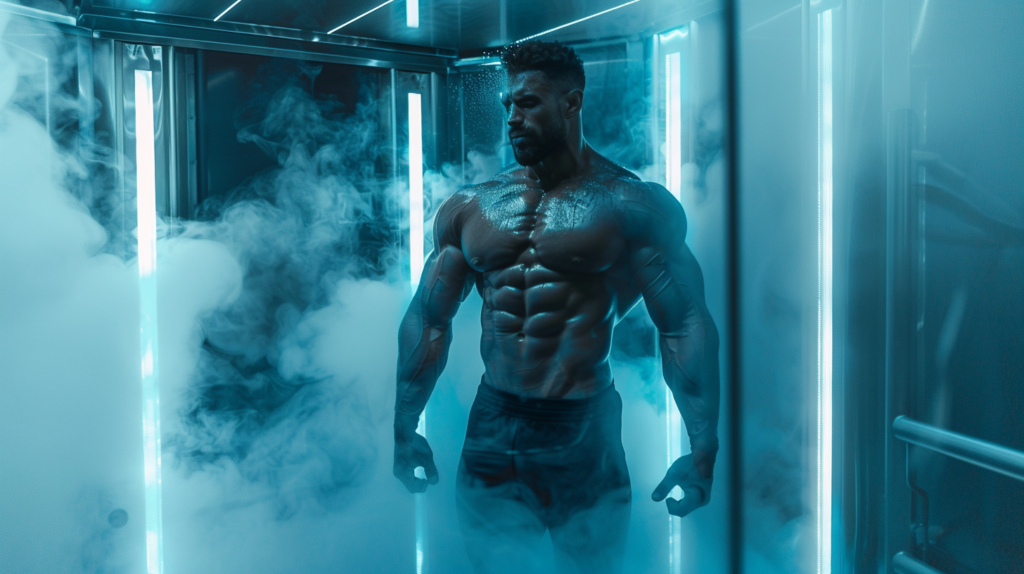For optimal muscle recovery in 2024, bodybuilders should prioritize these top seven techniques: Foam rolling reduces soreness and promotes self-myofascial release. Active recovery days optimize performance with gentle exercises. Proper nutrition includes key protein intake, carb cycling, hydration, and essential supplements. Quality sleep is crucial for muscle repair and performance. Stretching routines improve blood flow and flexibility. Cryotherapy sessions reduce inflammation and promote tissue repair. Massage therapy alleviates tension and enhances blood flow. These techniques form a comprehensive strategy for muscle recovery and growth in bodybuilding.
Key Takeaways
- Foam rolling for myofascial release and muscle soreness reduction.
- Proper nutrition with key nutrients for muscle repair and growth.
- Quality sleep to optimize muscle recovery and hormone regulation.
- Active recovery through gentle exercises for muscle relaxation and flexibility.
- Hydration to support nutrient transport, toxin removal, and muscle function.
Foam Rolling

We often find that incorporating foam rolling into our post-workout routine significantly aids in reducing muscle soreness and improving flexibility. Foam rolling benefits athletes by promoting self-myofascial release, a technique that targets the fascia, the connective tissue surrounding muscles, to alleviate tightness and improve blood flow.
By rolling our bodies over a foam roller, we can break up adhesions and scar tissue, preventing injuries caused by muscle imbalances and overuse.
Proper foam rolling techniques are crucial for maximizing its benefits and injury prevention. When foam rolling, we should start slowly and gently, focusing on areas of tightness or discomfort. Gradually apply more pressure as the muscles begin to relax. Remember to breathe deeply and maintain a steady pace to avoid causing unnecessary strain.
Foam rolling after a workout allows us to release tension in the muscles, aiding in recovery and improving overall performance. By incorporating foam rolling into our routine, we can enhance muscle recovery and prevent future injuries.
Active Recovery Days

Incorporating active recovery days into our training regimen is a strategic approach to optimizing muscle recovery and performance enhancement. These days provide a valuable opportunity for our bodies to recuperate while still engaging in beneficial activities.
On active recovery days, we focus on gentle exercises that promote blood flow, flexibility, and mental well-being. One effective way to spend an active recovery day is by engaging in a calming yoga practice. Yoga helps to stretch and strengthen muscles, improve flexibility, and reduce stress levels.
Additionally, incorporating mindfulness meditation into our routine can aid in mental relaxation and enhance our overall focus and clarity. Low-intensity cardio, such as a leisurely walk or light cycling, is another excellent option for active recovery. This type of exercise promotes blood circulation without placing excessive strain on the muscles.
Mobility exercises, like gentle stretching or foam rolling, can further contribute to maintaining flexibility and preventing injury.
Proper Nutrition

Optimizing muscle recovery and enhancing performance heavily rely on maintaining a proper nutrition regimen tailored to support bodybuilders’ specific needs and goals. Protein intake plays a crucial role in muscle repair and growth. It’s recommended to consume around 1.2 to 2.0 grams of protein per kilogram of body weight daily.
Carb cycling is another effective strategy where high-carb days can replenish glycogen stores, while low-carb days promote fat burning.
Hydration is key to muscle recovery as well. Adequate water intake helps maintain muscle function, aids digestion, and supports nutrient absorption. It’s essential to drink water consistently throughout the day, especially before, during, and after workouts.
Micronutrient balance is often overlooked but vital for overall health and performance. Ensure a variety of fruits, vegetables, whole grains, and lean proteins to cover all essential vitamins and minerals. Supplements can also help fill in any nutritional gaps, but whole foods should be the primary source of nutrients for bodybuilders aiming to optimize recovery and results.
Quality Sleep

Adequate and quality sleep is a foundational pillar in the muscle recovery process for bodybuilders. Sleep hygiene plays a crucial role in optimizing restorative sleep. Creating a sleep-conducive environment by keeping the room dark, quiet, and cool can improve the quality of your sleep.
Engaging in relaxation techniques before bedtime, such as deep breathing or meditation, can help calm the mind and promote better sleep quality.
Tracking your sleep patterns using technology can offer valuable insights into your sleep quality and duration. This data can help you identify any disturbances or areas for improvement in your sleep routine.
Additionally, incorporating recovery supplements like magnesium or melatonin, under the guidance of a healthcare professional, may support relaxation and enhance sleep quality.
Prioritizing quality sleep is essential for bodybuilders aiming for optimal muscle recovery. By focusing on sleep hygiene, relaxation techniques, sleep tracking, and considering recovery supplements, you can enhance your overall recovery process and performance in the gym.
Stretching Routine

Establishing a consistent stretching routine is key to supporting muscle recovery and flexibility for bodybuilders. Incorporating a mix of dynamic stretching, which involves moving parts of your body and gradually increasing reach and speed, and static stretching, where you hold a position for a set amount of time, can help prevent injury and improve overall performance. Additionally, varying your routine with partner stretching, where you work with a training buddy to deepen stretches and improve range of motion, and solo stretching, which allows you to focus on your individual needs and target specific muscle groups, can provide a well-rounded approach to enhancing muscle recovery. Below is a table outlining the benefits of each type of stretching:
| Stretching Type | Description | Benefits |
| Dynamic stretching | Involves movement and increasing reach/speed | Enhances blood flow and mobility |
| Static stretching | Holding a position to stretch a muscle group | Improves flexibility and range of motion |
| Partner stretching | Working with a partner to deepen stretches | Enhances muscle relaxation and joint mobility |
| Solo stretching | Individual focus on specific muscle groups | Allows tailored stretching for personal needs |
Cryotherapy Sessions

Utilizing cryotherapy sessions post-workout can significantly enhance muscle recovery for bodybuilders by reducing inflammation and promoting tissue repair. Cryotherapy involves exposing the body to extremely cold temperatures for a short duration, typically ranging from -200 to -300 degrees Fahrenheit. This rapid cooling triggers vasoconstriction, which helps decrease swelling and inflammation in the muscles, aiding in the recovery process.
The recovery benefits of cryotherapy are well-documented, with many athletes and bodybuilders incorporating it into their post-exercise routines. By constricting blood vessels, cryotherapy helps flush out toxins and metabolic waste products that accumulate during intense workouts, accelerating the healing process. Furthermore, the cold temperatures stimulate the release of endorphins, providing pain relief and promoting a sense of well-being.
Studies have shown the effectiveness of cryotherapy in reducing muscle soreness and improving recovery time between training sessions. Incorporating cryotherapy sessions into your muscle recovery regimen can lead to enhanced performance and overall well-being as a bodybuilder.
Massage Therapy

Incorporating regular massage therapy sessions into a bodybuilder’s routine can play a crucial role in enhancing muscle recovery and overall performance. Massage therapy involves manipulating the body’s soft tissues to alleviate muscle tension, improve blood flow, and reduce inflammation.
When targeting specific areas of tightness or discomfort, therapists may employ techniques such as trigger point therapy, which focuses on releasing knots in the muscles that can cause pain and limited range of motion.
For bodybuilders, deep tissue massage is particularly beneficial as it reaches the underlying muscle layers, helping to break down adhesions and scar tissue that may have formed due to intense workouts. This type of massage can aid in improving flexibility, reducing muscle soreness, and enhancing overall muscle function.
Frequently Asked Questions
Can Meditation Help With Muscle Recovery?
Meditation can significantly aid muscle recovery by enhancing the mind-body connection. It reduces stress, promoting mental focus and relaxation. These techniques are valuable for overall well-being and can complement physical recovery strategies for bodybuilders.
Is Epsom Salt Bath Beneficial for Muscle Soreness?
Yes, epsom salt baths can be beneficial for muscle soreness. They help relax muscles and reduce inflammation. Hot tubs also aid in muscle recovery by improving blood circulation. Stretching post-workout further enhances flexibility and prevents injury.
How Often Should Bodybuilders Change Their Workout Routine?
We believe workout consistency plays a vital role in maximizing muscle gains. By regularly changing routines based on training frequency and progress tracking, bodybuilders can avoid plateaus and keep their workouts challenging and effective.
Are There Specific Foods That Aid in Muscle Recovery?
When it comes to aiding muscle recovery, protein-rich snacks are like little repair crews for our muscles. These snacks provide essential amino acids for repair and growth, while staying hydrated maximizes their benefits.
Can Acupuncture Aid in Muscle Recovery for Bodybuilders?
Acupuncture benefits muscle recovery by promoting blood flow and reducing inflammation. Bodybuilders can experience improved recovery times and decreased muscle soreness with regular acupuncture sessions. Studies suggest acupuncture’s effectiveness in enhancing athletic performance and recovery.
Conclusion
In conclusion, implementing these 7 muscle recovery techniques will undoubtedly help bodybuilders reach their fitness goals faster and more efficiently.
By incorporating: – foam rolling, – active recovery days, – proper nutrition, – quality sleep, – stretching routines, – cryotherapy sessions, – and massage therapy
into your routine, you can ensure that your muscles are well taken care of and ready for your next intense workout.
Remember, recovery is just as important as training when it comes to building muscle and improving performance.













